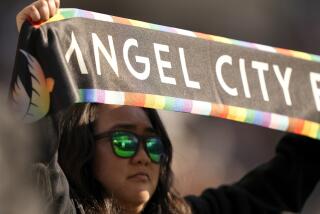Helping Youths Switch From Hooky to Hockey
NEW YORK — In this youth hockey league, only the ice is white.
The skaters hustling around a rink in Central Park are black and Hispanic children from one of America’s poorest neighborhoods. Their jerseys say, “Ice Hockey in Harlem.”
Far from the suburbs where such leagues are common, this one, started 11 years ago as an adjunct of the Upward Fund after-school program, is about much more than face-offs, blue lines and pucks.
“It’s about hooking kids in through hockey and getting involved intimately in their lives,” said Todd Levy, the league’s executive director. “It’s really not about making Wayne Gretzkys and NHL stars. . . . We all are kind of social workers.”
The program uses a straightforward carrot-and-stick approach: Students who work hard in school and stay out of trouble are rewarded with ice time, equipment, games, tutoring and mentoring at no cost. Top achievers go to summer hockey camps or on trips to places like Los Angeles, or even abroad.
And the league has a standing offer: If you earn admission to a prep school or parochial school, the league will pay your way. This year, about a dozen Harlem students are collecting on that promise.
Those with failing grades or poor attendance records are kept off the ice, barred from playing or even from practicing until they improve.
Fifteen-year-old Luis Gonzalez knows both carrot and stick.
He attended a summer hockey camp in Toronto. But when he stopped by the hockey program’s offices on the third floor of an East Harlem public school one recent afternoon, he’d been off the ice for a month because of academic troubles.
“Without this program, I don’t know where he’d be, because he keeps going back” to class to get back on the ice, said Debi Deutsch, the league’s social services director. She consulted with teachers and then cleared Luis to practice that evening.
Although his school attendance is spotty, Luis said the league has motivated him to consider the value of a high school diploma.
“I’m shaping up now. That’s how come I get to skate tonight,” said the 10th grader, who lives in East Harlem with his mother. “She likes it ‘cause it keeps me busy, so I don’t have time to walk around and do nothing.”
The league has grown from 40 participants in 1986 to 275 this year. It’s supported by the National Hockey League’s New York Rangers, who sponsor two annual fund-raisers that pull in about $250,000 to help pay the program’s costs, which Levy estimates at $2,000 per student per year.
Other contributions come from the city, which provides free ice time; Nike, which sends skates and helmets; and Rangers players like Gretzky and Jeff Beukeboom, who conduct clinics.
About 80 volunteers make the program run.
They’re people like Marc Siden, who coaches and mentors 16-year-old Joseph Diaz on and off the ice. Last summer, Joseph worked for VTR Capital, the Wall Street finance and venture capital firm that Siden owns.
Siden said his approach is simple: “If Joseph is doing well, I’ll do the world for him. If he’s not trying his hardest, he’s wasting his time and mine.”
young players learn a valuable lesson from the volunteers: how to listen.
“I like that; they pay attention when we talk to them now,” he said.
The boy’s father, Jose Diaz, said Diaz, a butcher in West Harlem, has two other sons in the league: Christopher, 13, and Jovanny, 10. He has arranged his hours so he can attend most practices. Before the league started busing players to practice, he used to drive his sons and their teammates in his station wagon.
“I like it because it keeps the kids busy, off the street, out of trouble,” he said as he watched his two youngest boys lace their skates before practice.
Teachers also like the program, Deutsch said.
Besides motivating students--”All they do is talk about Ice Hockey in Harlem,” she quoted a teacher as saying--it can make school more interesting. Mapping NHL franchises becomes a geography lesson; budgeting a Rangers road trip becomes an exercise in finance.
Some alumni have won academic scholarships to college.
This year, the league initiated a “Hockey Pups” program for 4- to 6-year-olds.
“If you don’t get a kid until he’s 12, you’re not going to get anywhere,” Levy said, noting that the Pups program increases parental participation.
“What better way to get parents really involved--like tying their kids’ skates on--than to have 4- to 6-year-olds?” he said. “They can’t come without their parents.”
Along with success stories, the league has its share of dropouts and kids who aren’t able to stay the course to a high school diploma and higher education or a job. One former player has been in jail twice on drug-dealing convictions.
“It’s really not an instant-gratification job,” Deutsch said.
Still, connecting with the kids who absorb the league’s lessons, on ice and off, is what keeps Siden volunteering.
“This program changes lives,” he said. “These kids lead the way. Because these kids want it so bad, you’re really motivated.”
More to Read
Sign up for The Wild
We’ll help you find the best places to hike, bike and run, as well as the perfect silent spots for meditation and yoga.
You may occasionally receive promotional content from the Los Angeles Times.






